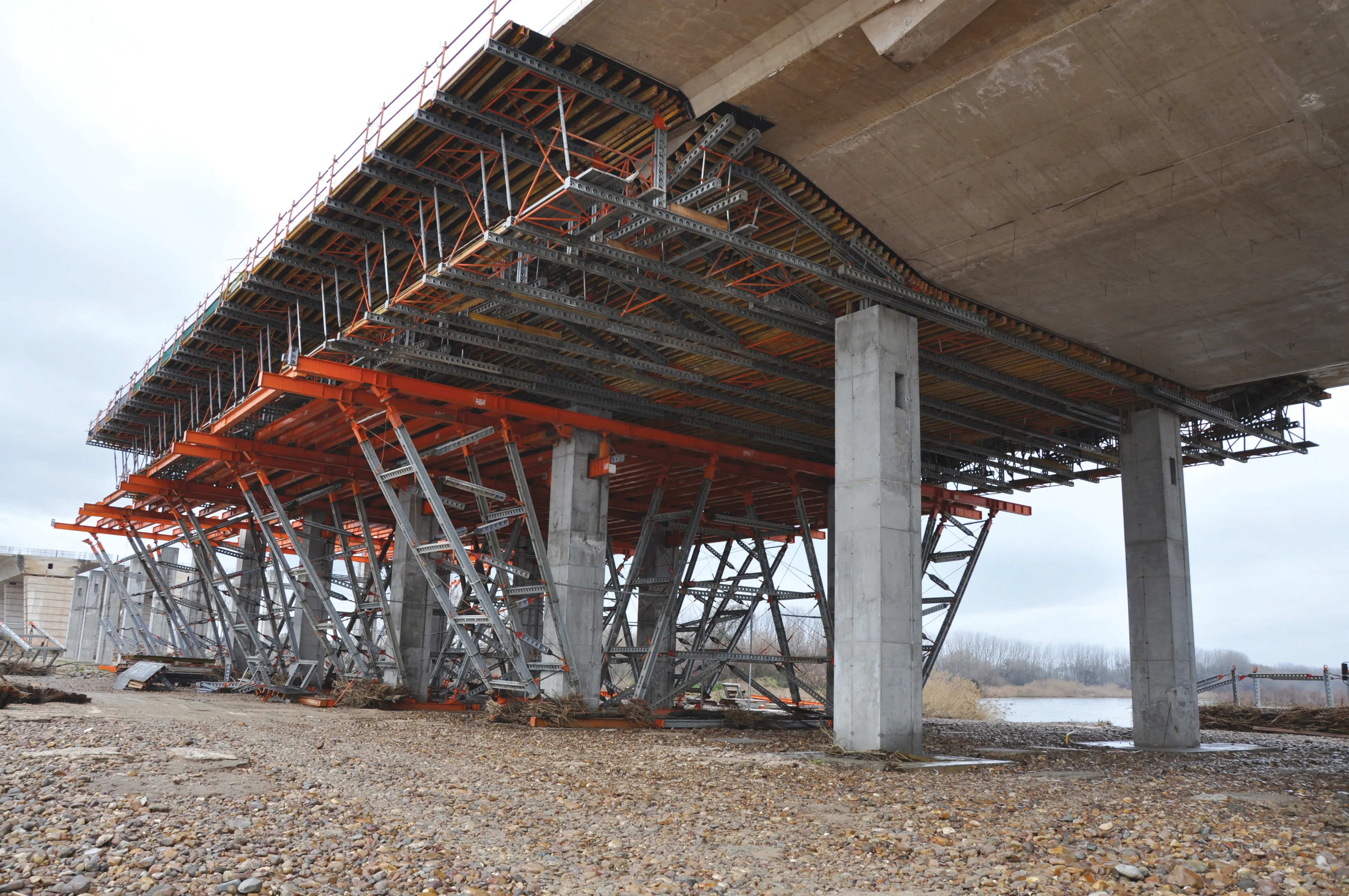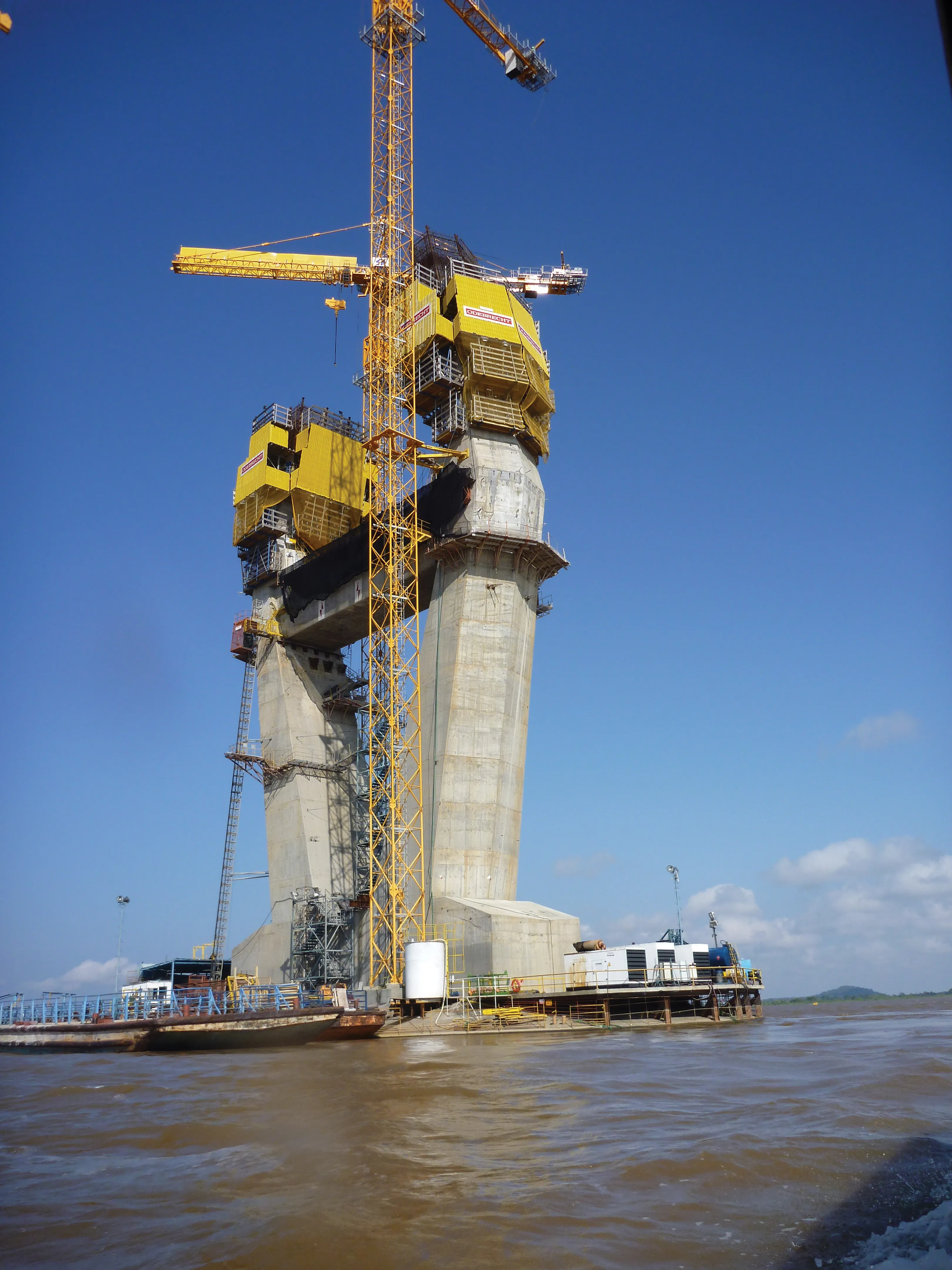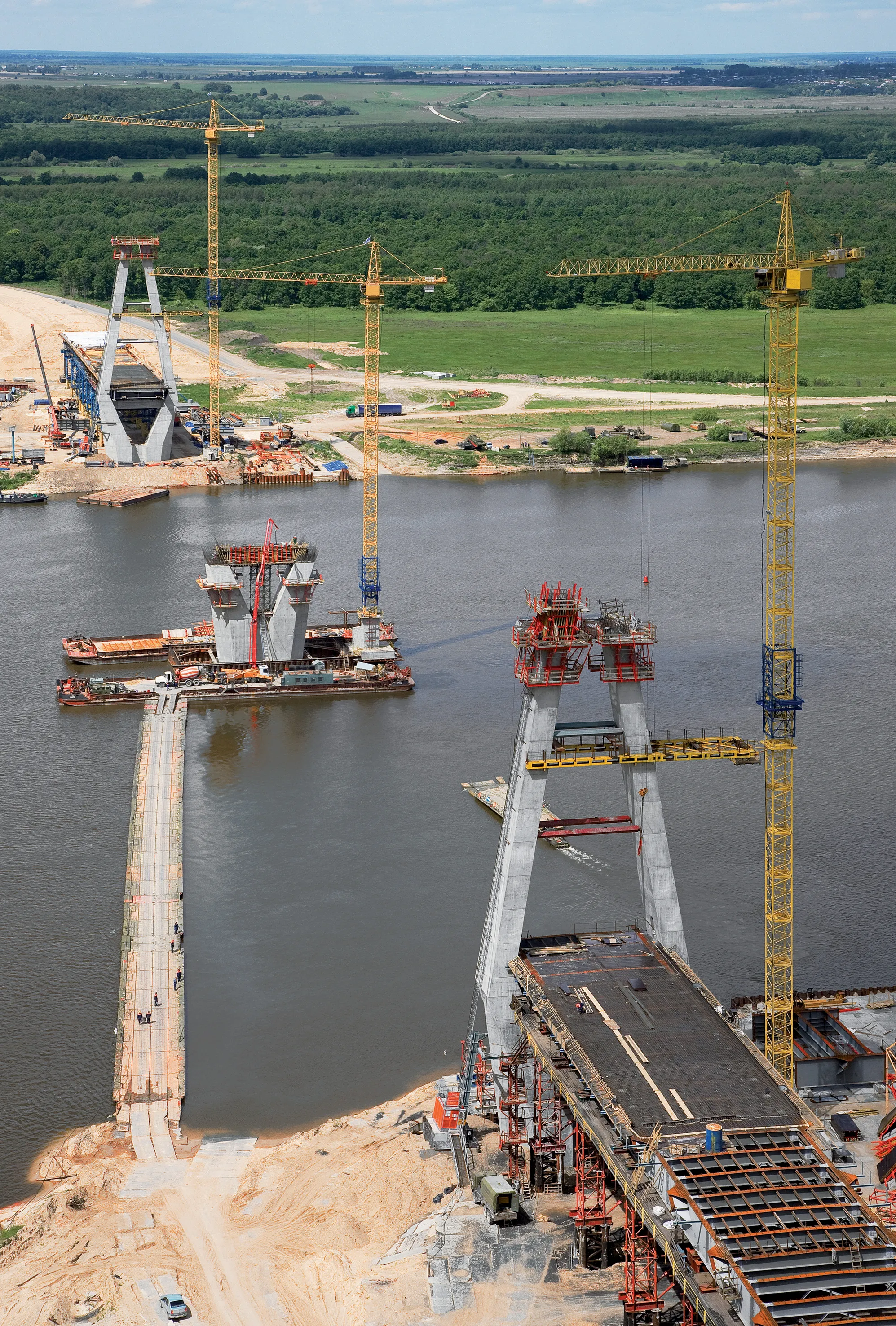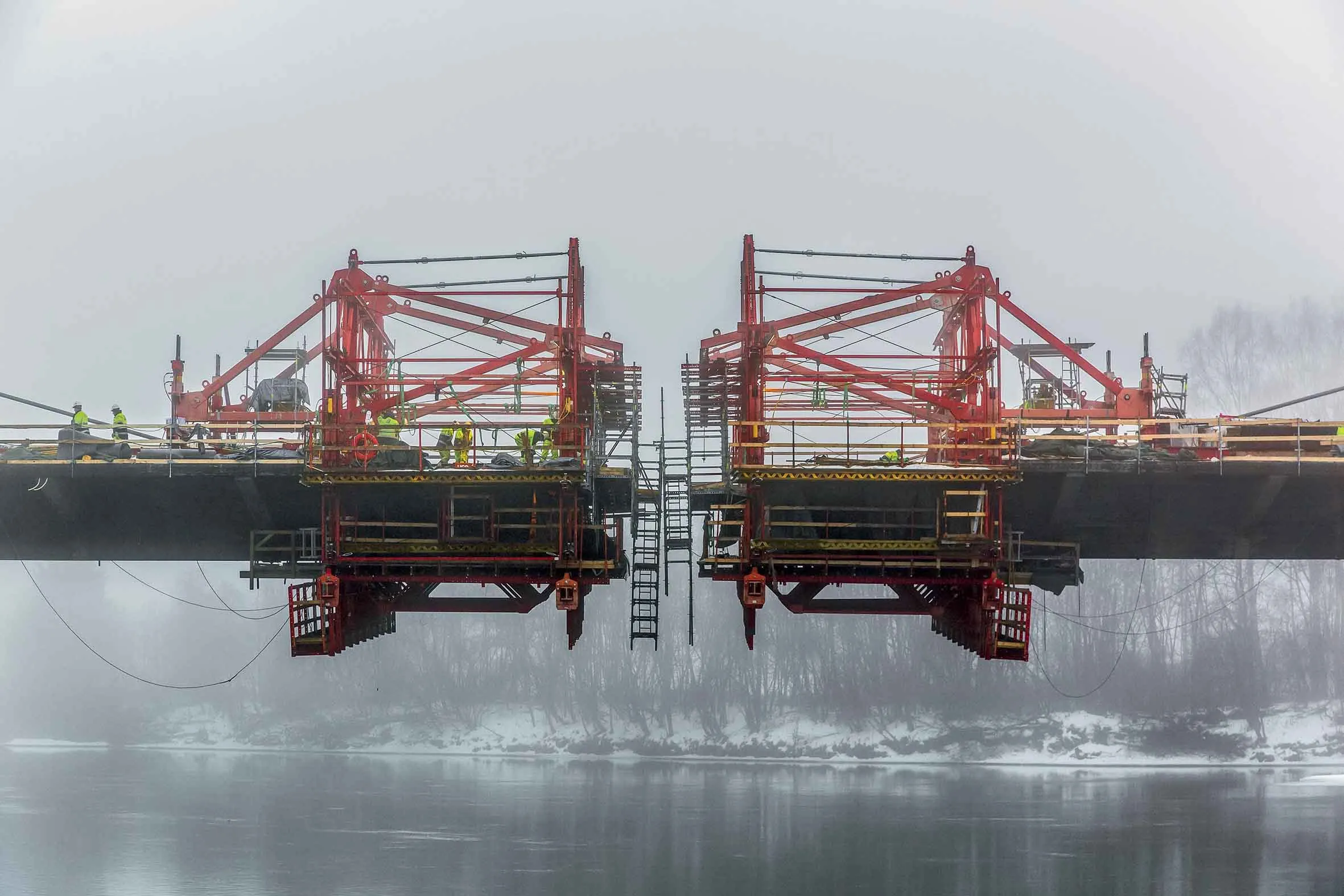Companies are coming up with innovative formwork solutions to overcome "challenging" designs for bridges. Patrick Smith reports
February 14, 2012
Read time: 9 mins

Companies are coming up with innovative formwork solutions to overcome "challenging" designs for bridges. Patrick Smith reports
Traffic volumes in Serbia's capital Belgrade have increased sharply over recent years, bringing the arterial roads linking the city centre and the outlying districts close to the limits of their capacity.A ten-lane cable-stayed bridge over the Sava River will significantly ease the severe traffic congestion and lop a considerable margin off the journey time between the capital's downtown and the New Belgrade district.
A total of 929m long, it is Belgrade's biggest bridge-building project in more than 30 years and with its architecturally challenging suspension tower soaring 200m into the air it will also be a new landmark for the city.
Lead contractors Porr Technobau-SCT-DSD decided that the construction of the elegant suspension tower called for an all-inclusive automatic climbing formwork solution.
Even before the project had developed past the planning stage, close cooperation between construction management and
The 45m wide superstructure (to carry the ten lanes) is being built by the incremental launching method also using Doka formwork technology.
Doka says that the first 175m of the single suspension tower is a challenging truncated cone geometry in CIP concrete. Up to the 98m level the tower features a centre incision, scissoring down to ground level in two legs. Each of these legs is characterised by a nearly semi-circular cross section and both are being climbed in 21 concreting sections with the Doka high performance SKE100 automatic climbing formwork.
The cross section tapers significantly as the tower rises and the automatic climbing formwork was designed by specialists at the Doka Expertise Centre for Automatic Climbing Formwork using a detailed 3D solid model.
The self-climbing formwork and the Doka Top 50 beam formwork have to adjust easily and quickly to the continuous taper of the structure's cross section, so the climbers are designed for maximum adaptability (the climbing platforms are carried on rollers on the outermost climbing brackets).
According to Doka this allows for relative movement between the outermost brackets and the climbing platforms, so the brackets follow the taper of the suspension tower legs without further adjustment.
The bogey units carrying the large-area Top 50 beam formwork assemblies can be moved on special rails along the climbing platforms and precision adjusted quickly and speedily to suit the changing radius.
"This solution puts us in a position to adjust the formwork easily and without loss of time to suit the changing geometry of the structure. The cross section tapers severely but even so we need only two sets of formwork to take us up the first 21 concreting sections: that makes for a tremendous saving on cost of materials," says Porr project manager Patrick Wagner.
Space is at a premium as the two legs come closer, so from the 13th concreting section on up the formwork on leg 1 climbs up to three sections ahead of its counterpart on leg 2. The leg 1 formwork is removed after the 22nd concreting section so that the formwork on leg 2 can complete its climb unhindered.
Each automatic climbing formwork assembly incorporates a follow up platform so that the necessary finishing work on the concrete surface can be conducted to maximum efficiency.
The Top 50 large area panels were preassembled in the Doka Belgrade branch and delivered just in time and ready-to-go, streamlining on site logistics.
From the point at which the two legs join, the suspension tower is climbed as a narrow tapering truncated cone with the newly-developed SKE50 plus automatic climbing formwork. The tower's diameter slims from 9.5m at the 22nd concreting section to 4m at the 39th. Eight platforms are arranged in a radial configuration with integrated adapters so that the assembly adjusts as the cross section tapers.
The southern section of the bridge (back span) is 200m long, and is divided into 18 concreting sections, having the 45m wide roadway slab, which cantilevers out 12m to each side of the three-cell box girder, and this was another major design challenge. The two outer cells of the supporting structure are each 2m wide and are being cast with Doka forming carriages based on Top 50 beam formwork. The forming carriage for the main cell, 8.5m wide, is also made up of Top 50 panels with Staxo 100 frames as propping.
'World-beater'
What is said to be the widest, single pylon concrete cable-stayed bridge in the world today is being constructed with formwork and falsework fromDeveloper UTE RONDA SUR DE TALAVERA, a joint venture between Sacyr, Aglomancha and J. Barcenas, awarded this contract to RMD Kwikform Iberica for the cable-stayed bridge structure and two viaducts along the Ronda Sur road in Talavera de la Reina, Toldeo Province, Spain.
The 316m cable-stayed section of the Talavera Bridge reaches across the widest part of the river Tajo in a single span. It comprises a 36m wide deck anchored to a single 190m tall pylon by 38 cables on each side of the deck.
Before work could start on the project, the river had to be channelled and an artificial peninsula created to provide adequate access to the site (the river will be returned to its normal course and natural state when work is completed).
Temporary piers, built along the artificial peninsula to support the ongoing construction of the bridge, will be demolished when the cables are in place and tensioned to take the load of the bridge.
The peninsula, which gives site access and which is liable to flooding, was created using the foundations of the temporary piers to anchor RMD Megashor towers. To shore the full span of the bridge deck the Megashor towers were arranged in a 'W' shape and anchored at the pier foundations. This allowed the Megashor towers to be securely anchored against potential flooding and provide a wide enough platform to support three joined-together 12m RMD450 beams to create the 36m wide deck formwork.
In forming the deck there are a number of curves and polygons in the design of the bridge. Special parts were designed and created for different parts of the deck to achieve the client's desired angle and shape for the concrete. Further special components, developed by RMD Kwikform Iberica engineers, have been used in the construction of the superior deck.
The key to delivering the deck was to ensure it could be poured and cast in one go, and this meant accommodating formwork for the bridge's four internal cavities and accommodating the all-important transversal bars that stiffen the deck preventing any distortion once the pylon's 76 cables are attached.
"To accommodate the transversal diagonal bars we developed a metallic mould that would create the concrete block that would receive these bars. Once the mould and the bars were in place this would allow the superior deck to be created in a single pour," says Julio Merino from RMD Kwikform Iberica's engineering department.
"The cables supporting the bridge need to run through the bridge to concrete blocks that receive them on the underside of the deck. Here we had to pass a tube through the deck at a very precise angle, different for each cable. To ensure the angle was perfect, an auxiliary structure was created from [RMD] Superslim Soldiers, allowing us to make precise adjustments in height, angle and length and then lock the position of the tube ready for pouring with the cables in situ.
"The superior deck is angled on each side. To create this geometry with the formwork we adapted the standard IPE80 beam. We cut the beams to size to adapt them to the geometry of the deck and we added mounts for props on its underside that allow it to connect to telescopic props." The 4.5m high, 22m deep and 16m wide bulkhead, which provides the stage for the single pylon, is built on a 4m high pier structure, meaning that formwork was required to accommodate a height of 8.5m and withstand the pressure of enough concrete to cast the bulkhead in a single pour.
The solution consisted of formwork panels using Superslim Soldiers as primary vertical beams, and secondary T200 timber cross beams. These are then supported with adjustable Superslim Soldier props called push-pull props, which are adjusted between its axis. This allowed the structure to withstand the load produced by the sizable auto compactable concrete pour.
RMD Kwikform Iberica is due to finish work on the bridge at the end of July 2010.
A 515m long cable-stayed bridge connects the Bretonic mainland in the north-west of France to the Crozon peninsula, and to realise the arch-shaped superstructure construction, the geometry of the pylons resembled that of the Greek letter ? (Lambda).
The Térénez Bridge replaces an existing dilapidated construction, and has a main span of 285m and the two pylons each with a height of around 100m. The 6.5m wide two-lane carriageway is supplemented on both sides by a 2.4m wide lane for pedestrians and cyclists.
The curvature of the bridge superstructure was planned in such a way which allowed the course of the access roads to be changed, eliminating hairpin bends so that the river can now be crossed with more safety.
The resulting form of the bridge pylons required an adaptable formwork construction. On basis of the
In addition to the complicated pylon geometry, high safety requirements were also to be maintained.
With the help of the ACS climbing device, all four pier sides could be climbed together without intermediate anchoring. As a result, the working platforms were secured at all times without requiring any additional measures.
The VARIO GT 24 system was used on the climbing brackets. This girder wall formwork with the continuous panel connections can be used for almost all shapes and applications. In the process, the panels are optimised to suit project requirements: the type of formlining, its size and mounting are just as freely selectable as element width and height, vertical or horizontal tie arrangement as well as the permissible fresh concrete pressure.
"The flexibility of the VARIO system allowed the construction site crew to accurately adapt the formwork to the continuously changing geometry of the bridge pylons," says PERI.
"The rows of slotted holes in the steel walers and couplings allow continuous tightening of panel joints. In addition, the VARIO GT 24 coupling ensures flush panel connections and adjusts any possible assembly inaccuracies. This led to achieving perfect concrete results."









